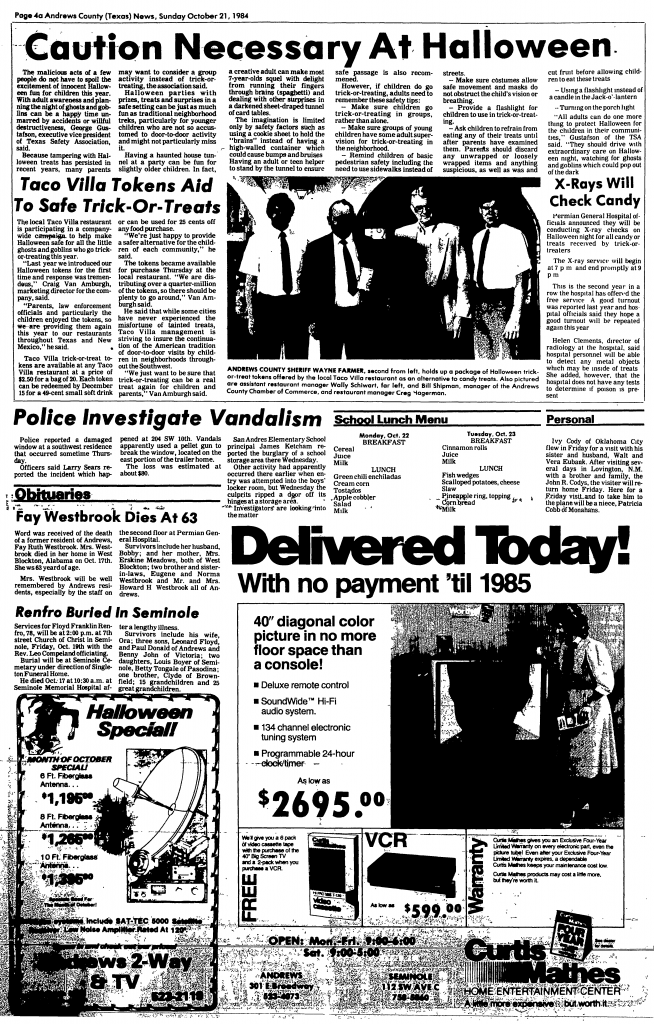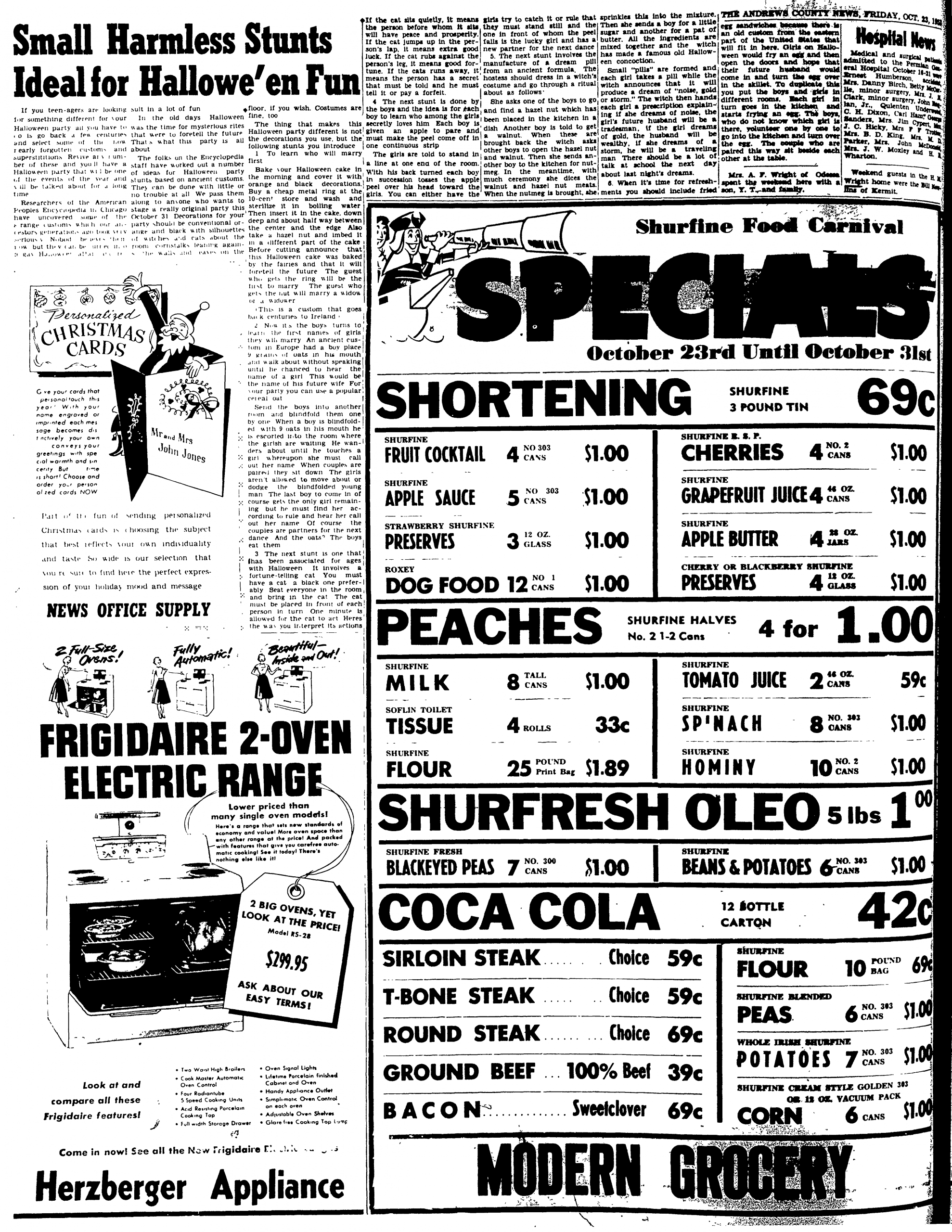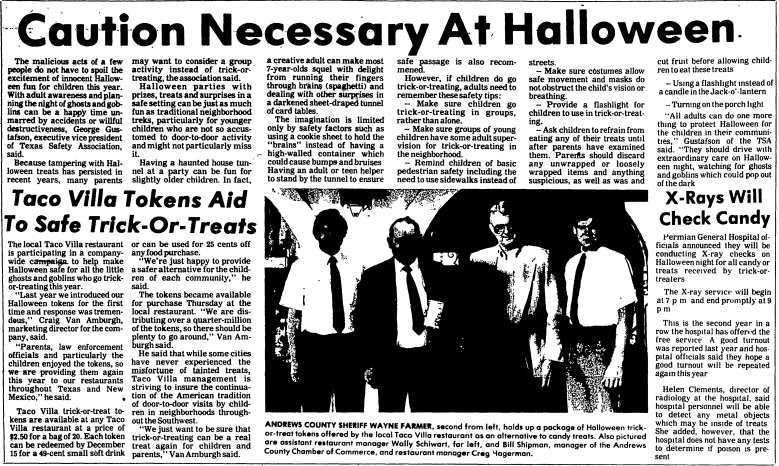Starting off we have some Halloween-themed treat recipes from Fort Stockton, Texas. These recipes were published in the Fort Stockton Pioneer on October 20, 2011. The article briefly describes the origins of Halloween– it was originally a Celtic festival called Samhain– and compares the similarities between the festival and modern traditions. The author’s personal favorite Halloween tradition is making spooky cupcakes, and she includes instructions on making pumpkins of multiple varieties. If you’re interested in baking some Jack-O-Lantern cupcakes this Halloween, be sure to check out these recipes!

Next up, we have some advice for staying safe on Halloween, shared in the Andrews County News on October 21st, 1984. They cite incidents with contaminated candy as reason to exercise extra caution that year, sharing tips related to this issue and other generic safety precautions. Included were suggestions like making sure kids go in groups with adult supervision, reminding them of road safety rules, making sure costumes do not restrict movement or vision, sending your kid with a flashlight, and encouraging them not to eat their candy until it can be examined by an adult. They also mention that the local fire department will be available for any parents who want to X-Ray check their candy to make sure there was nothing harmful in it. It makes me wonder how big of an issue with contaminated candy they had to warrant such precautions, but it isn’t terrible advice by any means! It’s always better to be safe than sorry.
(1945 – 1980s) Old Customs Made New: Halloween Party Activities, 1953
Now that we have our safety tips in mind, we can talk about more halloween traditions. This article, published in the Andrews County News on October 23rd, 1953, goes back in time to early customs associated with Halloween that you could bring back to modern times. The first custom comes from Ireland, and involves a fortune telling cake. Well, not literally a fortune telling cake, but it’s still a fun idea for a halloween party. In this tradition, you back and decorate a cake with halloween colors, but hide a ring and a nut in the cake. Whoever receives the slice of cake with a ring in it is said to be the next to get married. The person who receives the slice with the nut is believed to marry a widow/widower. This tradition reminds me of a New Orleans mardi gras tradition– King Cakes! The other customs included are also of the psychic varieties, ranging from a fortune telling black cat to a nut scavenger hunt run by a witch. If you are looking for some new prophetic party games, be sure to check out this article!

Finally, we have an example of a classic halloween costume contest. This information comes from the Arthur Graphic Clarion, published on October 23rd, 1941. The paper shares the schedule of celebrations for the town of Clarion, Illinois. The Halloween party starts with a parade, followed by a costume contest offering prizes in a variety of categories. One winner was to be picked in eight best costume categories, including best individual costume, best costume by a teacher, best costume by a high schooler, best costume by youngest person, and best costume by oldest person, among others. Then, the winner of each category received a $2 prize and a spot in the final contest for the $7.50 grand prize. The costume contest was followed by a halloween carnival and gala for everyone! This is a great example of a classic halloween party, and would be easy to incorporate into your plans this year!
I hope this helped you get into the halloween spirit and start thinking of how you’re going to celebrate this year! And don’t forget, if you live in Iowa you should double check whether your city is trick-or-treating on beggars night or halloween night! Join me again next week to discover more of history’s hidden gems and timeless tales.
Explore the “Read All About It” archives to read stories that spotlight our partners and their communities, announcements from our team, updates on current projects, and so much more. Discover articles about engagement, outreach, primary sources, community, digitization, education, and other topics of interest. Delve into the happenings in this week in history and take a deep dive into the events and people who helped shape our communities, our nation, and the world.
Hear Ye, Hear Ye, READ ALL ABOUT IT!
Advantage Archives works to build strong, community-based partnerships to provide free online access to local history, making it discoverable and easily accessible to anyone, anywhere, at any time, on any device. This allows communities to understand and connect to their past in a meaningful way. Through the Community History Archive search platform, we provide the community with the means to explore, discover, learn from, connect with, and share the stories of the people, places, and events that shaped their community.
The Community History Archives are intended to serve as a “portal to the past”, allowing local primary source documents to give an accounting of history as told by the individuals that witnessed it. Advantage Archives guiding principals center around building strong community-based partnerships, which is why we enter into them with the intent of shouldering our fair share, and taking the burden off of the community for the ongoing costs associated with storage, hosting, development, and maintenance of the Community’s History Archive. We are an active participant in the community’s efforts to make their collective history more accessible. The Community History Archives are maintained for free by Advantage and do not require a subscription, seat license, annual support contract, or any other ongoing costs or expenses to the institution or members of the community.
If you would like to see more local history online, please contact your local library, newspaper publisher, genealogical society, historical society, or educational institution, and encourage them to learn more about creating a Community History Archive or have them contact Advantage Archives at (855) 303-2727



